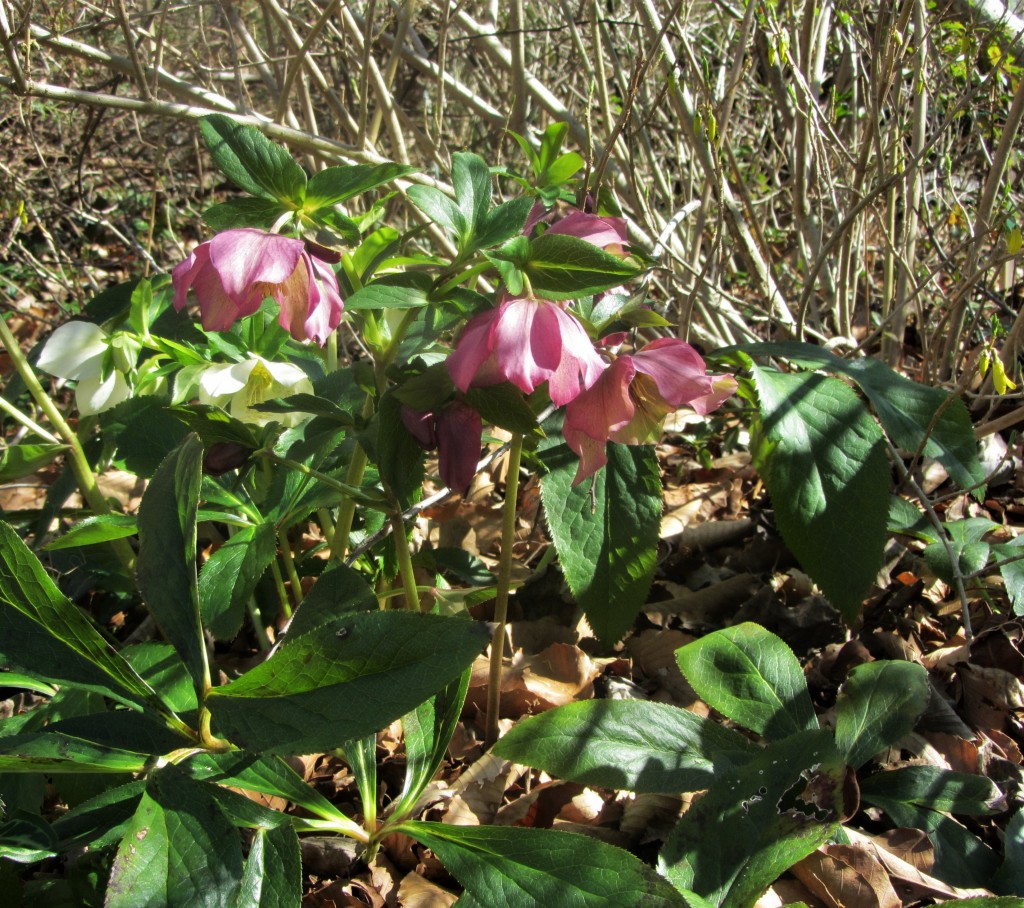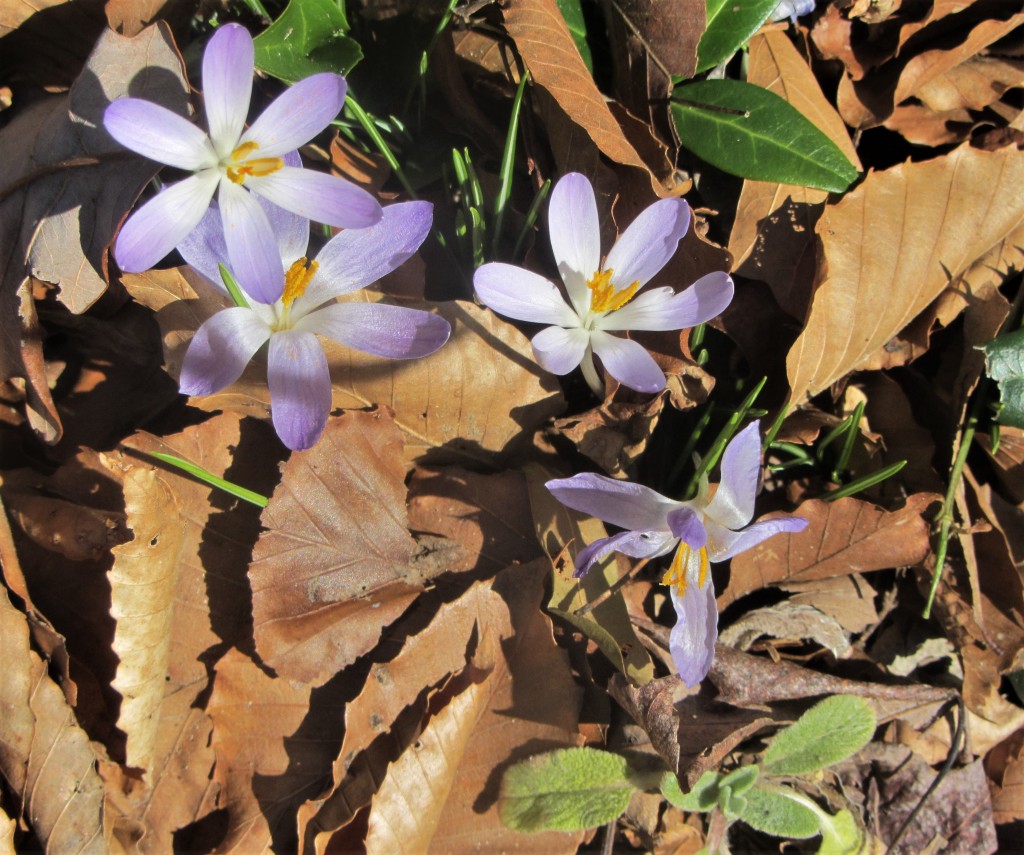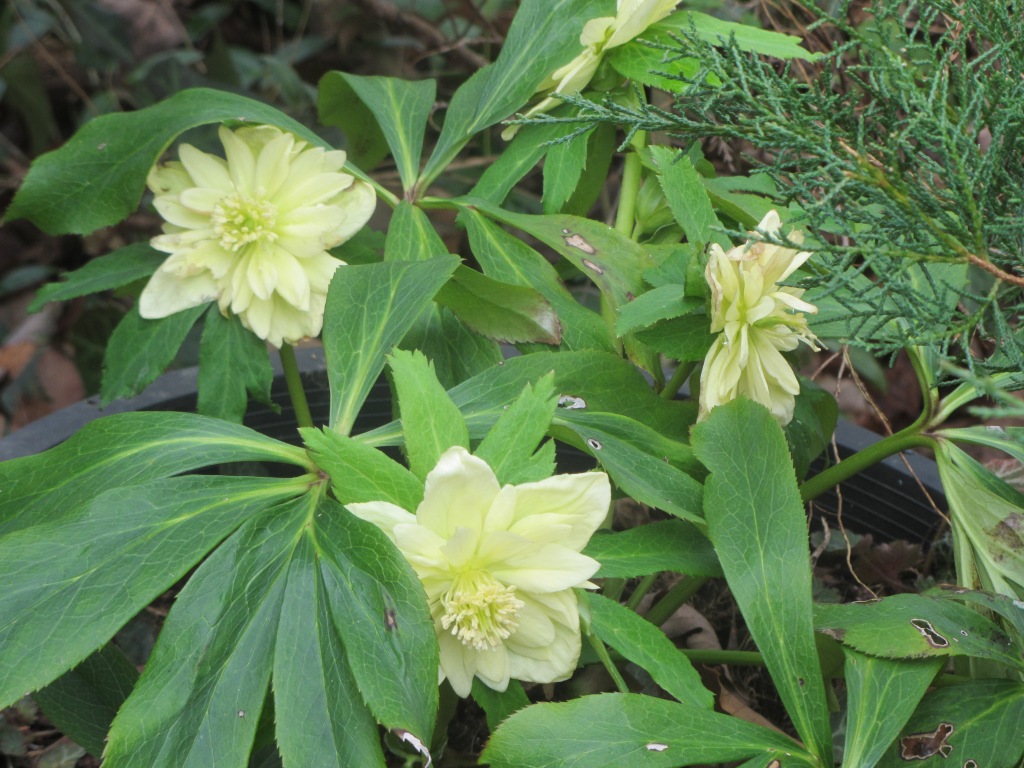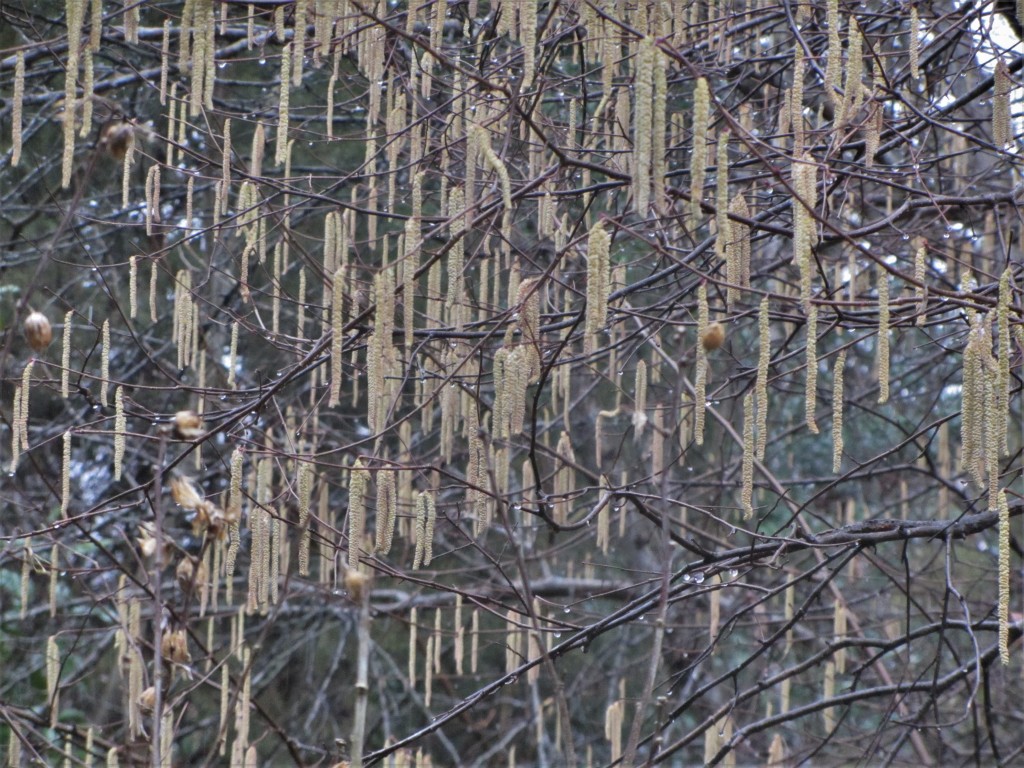
Spring is simply magic unfolding hour by hour, week by week, to transform the bleak winter landscape we’ve gotten accustomed to into the vibrant, colorful garden we’ve held in our heart. Each opening bud sparks recognition, like the face of a friend who has been away for a while.
I bought a hellebore late last season and put it into a pot on the patio. All summer I looked at it with curiosity, wondering about the color and shape of its bloom. It has remained vibrant and green through all of the seasons, apparently happy in its spot. But no hint of a bloom. Until earlier this week a few buds emerged. So soon enough we’ll see its face.
It can be easy to forget exactly which flower a Camellia shrub or Iris clump produces. And then they unfold at exactly the right moment, and we say, ‘Yes! Of course! I remember now!” Sometimes I wish I’d left the photo plant labels sticking up near each stem and clump as a reminder, or maybe made the detailed labeled garden maps some more organized gardeners keep.

I often plant in a moment of inspiration and then move on, sure that I’ll remember. And then I promptly forget what is where. It happens… especially with the ephemerals like the spring bulbs and the deciduous ferns. But then their reappearance and growth feels all the more magical when they return, usually multiplied over earlier seasons.
That is where garden photos come in handy. I’ve spent hours this week looking back through photos from previous years to locate photos of specific plants. Late winter is a good time for me to look back at how beds and pots have evolved over time, and make some mental notes about what plants and associations I want to grow in the coming gardening year. It is a little nudge to remember what is where, what to expect to emerge and what may need to be replaced.
One reason that I was looking for all of those photos is because I’m in process of moving a series of articles that I wrote last year for a local newsletter to this website. The series was called ‘Plants I Love…. and Deer Ignore’ to highlight tough, easy to grow plants that deer leave strictly alone. I’m no longer keen on ‘deer resistant’ plants. Those disappear in the night to the deer who ‘didn’t get the memo.’ I’ve been observing plants in this garden for a dozen years now to learn what plants deer won’t bother, and writing about those plants.

I thought that other gardeners might appreciate a ‘go-to’ list of reliable, easy, deer-proof plants. So I began writing the series last May. You’ll find all of them posted to Our Forest Garden by the end of this coming week, and I’ll continue adding plants here over time. My plant list is sometimes controversial in some circles, so I will continue the series here on Our Forest Garden.
I am interested in functional, beautiful plants that support wildlife, sequester carbon, hold my steeply sloping ground against erosion, and perhaps colonize a bit to reduce the number of plants I’m buying each year. I hope that others find these plants useful for their own purposes.
There is a great deal of debate in American gardening circles these days about ‘good plants’ v. ‘bad plants.’ About whether plants should be chosen for their aesthetic, or for their function in the local ecology; and about whether non-native plants should be planted at all.

I came across an interview with Dr. Doug Tallamy in the March/April Horticulture Magazine this week, which helped put it into perspective for me. He observed that about 14% of our native plant species here in North America support more than 90% of the butterflies, specialist native bees, and other insects we need to support (and save from extinction, really) to maintain the entire food web. Our concern shouldn’t be ‘native plants’ v. ‘non-native plants.’ Rather, it should be ‘functional native plants’ v. ‘all other plants.’
That rings very true to me. Dr. Tallamy goes on to provide lists of the essential native plants, like oak and maple trees, which support the majority of insect species. If our gardens provide these essential native host plants, then we can still plant and enjoy our hellebores, daffodils and Dahlias and other beautiful plants that we enjoy. Many of these flowering ‘non-native’ plants support pollinators and birds, and are otherwise functional in our gardens. They just were originally found in other corners of the planet.

Part of the magic, for me, is finding beautiful birds, butterflies, turtles, frogs, and so many other creatures living in the gardens that I tend. If they can support themselves and raise their young in my yard, maybe I’m doing something useful for the greater environment and not just creating a beautiful space for myself.
Dr. Tallamy first wrote about his concept of creating ‘Homegrown National Parks’ in his 2020 book, ‘Nature’s Best Hope: A New Approach to Conservation That Starts in Your Yard.’ I have been writing about those ideas this week, and you’ll find my article, Invitation to a ‘Homegrown National Park,’ on our local Master Gardener website.
Signs of life have emerged all over our garden this week. New birds have turned up, and the Forsythia is blooming. I’m finding wonderful surprises as the hellebores and daffodils bloom. We have a spot of warmth this weekend before temperatures plunge again in the coming days. I’m itching to plant something, and it is a good time to get back out into the garden.

I agree, I do love Spring, is feels magical.
LikeLiked by 1 person
Great post, E! I love how you describe the magical unfolding of the garden in spring, and esp. those ‘surprises’ that we forgot about. It’s like revisiting the magic of childhood.
Thanks for the heads up on the DT article in Hort Mag… I will look for it. x
LikeLiked by 1 person
It is excellent. There are actually 2 articles, the other more specifically about his ‘Homegrown National Park’ initiative. This is an especially good issue. I love that he supports a wider vision of what to plant, and how to plant to make a real positive impact on the local ecosystem. Wish I’d had this info 30+ years ago! Spring will find you soon. I hope you at least have a breath of relief this weekend.
LikeLiked by 1 person
Very thoughtful post. I love the idea that planting or preserving keynote species gives us permission to plant whatever else we crave.
Also, while I look forward to your deer resistant list, I could really use a list for rabbit resistant plants. When you have a moment!
LikeLiked by 1 person
Thanks so much for your note. I have grown beyond weary with the arguments over what is ‘good’ to plant and what isn’t. I respect Dr. Tallamy’s view of planting ‘functional’ plants that go a step beyond pure aesthetics, but that includes a wide variety of plants we have emotional attachments to or that we simply enjoy. All green growing things serve their purposes, even if it is simply to filter the air. If you haven’t discovered Benjamin Vogt, I highly recommend his website and his first book, which is a quantum leap beyond even Tallamy when it comes to restoring ecosystems through residential planting. Rabbits are much like deer in their tastes, except they don’t have the height to do as much damage to trees and shrubs. I go into more depth about planting where there are hungry critters in these two articles: https://jccwmg.org/wordpress/but-will-deer-eat-it/ and https://jccwmg.org/wordpress/who-is-welcome-to-dine/ I hope they will help you with an idea of how to plant rabbit resistant plants. I also use granulated Plantskydd over tasty treats, like pansies, and only need to renew the coverage over 6- weeks. It works. Have a great week!
LikeLiked by 1 person
I agree, the wokeness of appropriate gardening is exhausting. Thank you, I will definitely look at Benjamin Vogt.
LikeLiked by 1 person
Did you happen to see the picture of the three extra beautyberry seedlings that came with the six that you sent to me? I separated them while they are still dormant, and plugged them into three separate cells. One is difficult to see in the picture, and may not survive, but is worth trying for. The butterfly ginger started to grow early, only to get frosted, which is weird. Warm weather is not uncommon through winter, but such late frost that continues for a few days is rare.
LikeLiked by 1 person
Hi Tony, Thanks for the ‘heads-up.’ I’ll spend some time going through your site looking for that photo. So sorry to hear that your Hedychium got frosted. I hope it will try again. We have a cold snap coming in a few days, and I’m worried, too, about what it will mean for plants that start out over this very warm weekend. Let me know if you need replacements. Best, e
LikeLiked by 1 person
Oh, the ginger will be fine. It just started to grow because the weather gets so pleasantly warm during the day, but then it got slightly frosted during the night. The frost is minor here. The buds below the damaged foliage are fine. The picture of the beautyberry seedlings posted at midnight yesterday morning (Saturday), but barely shows only three dinky seedlings that I separated from the other six. I just thought that you would find the picture to be amusing if you happened to see it.
LikeLiked by 1 person
Yes, they look so tiny, Tony. I didn’t even realize those little extras were there. I’m glad that you had several seedlings survive and hope you have your first flowers this fall. Beautyberry can be really fast when it is happy. I loved all of your articles about ground covers. I was writing about living ground covers and their benefits last week, but was focused on perennials rather than woodies. Your comments about Hedera made me chuckle. It is iconic in this area, yet we still have a good number of folks who want to do battle with it. I am much too lenient and let it grow- to a degree- because I find it beautiful.
LikeLiked by 1 person
So far, the six primary beautyberry seedlings are doing well. Their terminal buds are green, as if they are about to foliate. The other three may not survive, but if they do, I wanted them to be separate from the primary six seedlings. The seedling in the middle, which is difficult to see, seems to have been broken off, so lack any buds so far. It will need to generate adventitious buds to survive. One of the others lacks a green tip, so may not foliate.
I forget what I said about English ivy. It is a major weed here, but it is also a useful ground cover. If we had more gardeners, we could keep some it out of the trees. Fortunately, it does not climb many redwoods. Weirdly, when it finds a redwood that it can climb, it does so voraciously. It is weird to see a single redwood infested with English ive in a forest of otherwise bare trunks. One such ivy infested redwood lived across the road from one of my vacant parcels in Brookdale, but the ivy somehow burned off from the fire. It is as if it was never there.
LikeLiked by 1 person
I cut beautyberry back very hard in late winter and it regenerates growth in amazing ways. It is a suckering shrub, but those buds just emerge right from the bark where nothing was previously visible for new stems. It is fun to watch how determined it is to live. As with most plants, the key is in how viable the roots prove in supporting the plant when it is ready to begin growth. Fingers crossed that yours will all grow! I never considered that the fires would also address invasives like ivy. That is great to know. My daughter spent many, many hours trying to cut back all of the ivy on fences and trees around her house and has a few choice words to describe it, too. Her ivy is much heavier leafed, and thicker stemmed, than any that we have in this area. We have a beautiful variegated ivy growing around our home as a ground cover, and I’m pulling it off the walls several times each year, so it does require attention to maintain.
LikeLiked by 1 person
Once the beautyberry gets established after a few years, I would prefer to coppice it. I thought that I would need to alternate canes, but then found that it blooms on new canes, so does not need canes from the previous years.
The ecosystems here are adapted to occasional burning. Most vegetation burns efficiently, and some uses fire to its advantage. Redwoods are one of few species that survives fire by being less combustible. Fires typically burn around redwood forests. Even if the foliage burns away, redwood trunk survives to regenerate. Many of the most invasive exotic species here are from similar climates, so regenerate very efficiently after fire. However, those that are not from such ecosystems do not regenerate so well. Ivy can regenerate from stems that lay flat on the ground, but those that were up in trees were likely killed. I really do not know, since I can not see what happened to the ivy that was up in the trees. It is all gone, as if it was incinerated.
LikeLiked by 1 person
Hello WLG,
Great points about diversity and the value of whichever plants provide the food for our native insects. Our own local National Botanic Garden of Wales is doing great work on finding (through pollen studies), just which species provide the majority of their diet, and it’s a surprisingly limited range. More particularly in late winter/early spring, there are almost no options unless we gardeners grow non natives – like Daphne, hellebrores, snow drops and Crocus,
Best wishes
Julian
LikeLiked by 1 person
Julian, Thank you so much for that information. I had observed that here, but didn’t have the research to back it up. Good for the NBG of Wales for doing those pollen studies. In our area, shifts in our climate allow the native insects to grow active earlier than in previous years, and remain active much later. We have some good native plants for late season, but very few for early spring. It is the non-natives that you mentioned, plus a few others like the Magnolia stellata, Asian Prunus, Asian Pieris, flowering quince, and Edgeworthia chrysantha that make the difference for pollinators. We don’t even have clover blooming in the lawn yet! Best wishes, WG
LikeLiked by 1 person
Hello WG, Here’s one of their recent papers you might enjoy perusing…
https://www.nature.com/articles/s42003-020-01562-4
It’s quite a clever comparison of changes in honeybee diet over the years, ‘cos of agricultural practive changes and probably also climate change.
Pieris are certainly great plants here too – though they come a little later with us, but we struggle with the Edgeworthia, lovely though it is – ours was looking good then got knocked by a harsh winter followed by a very hot dry summer,
best wishes
Julian
LikeLiked by 1 person